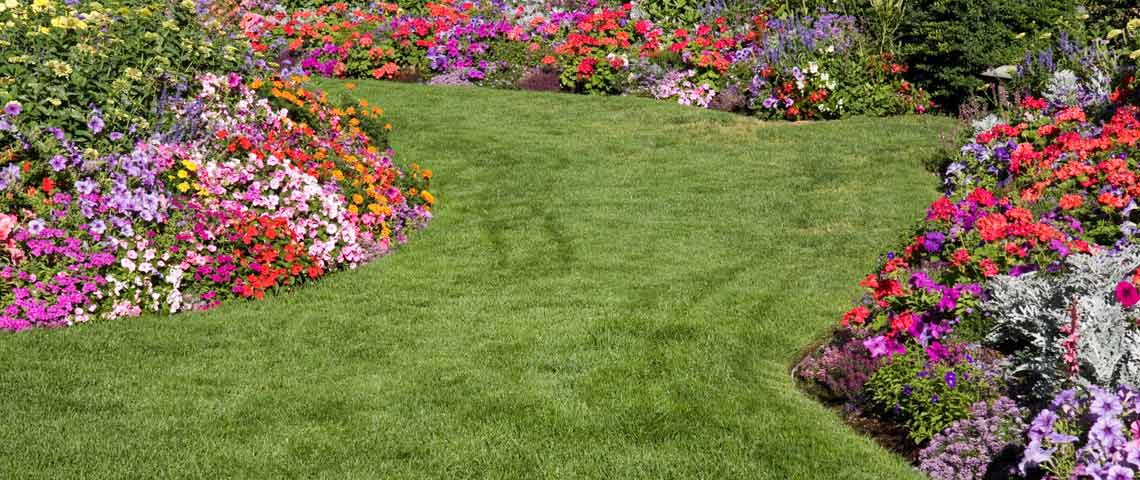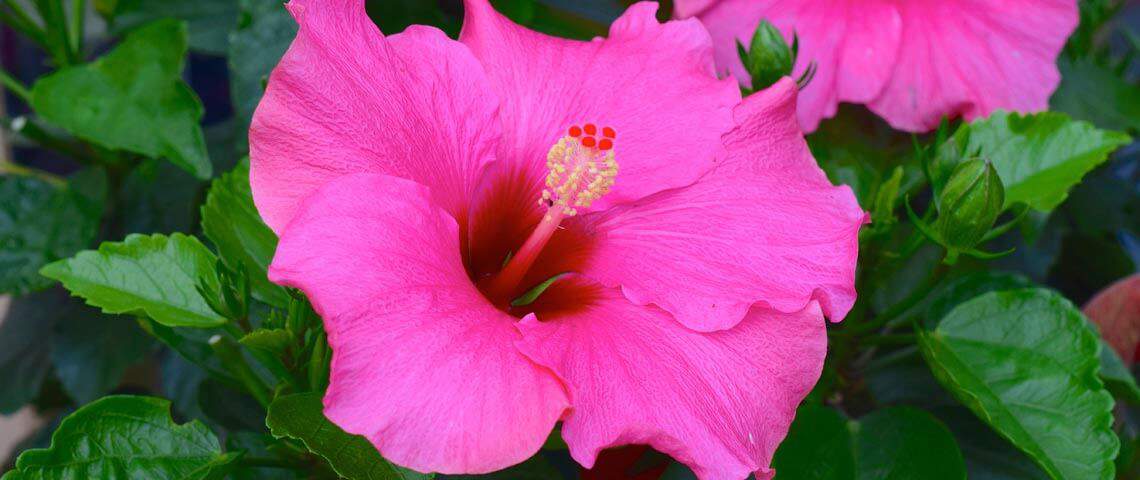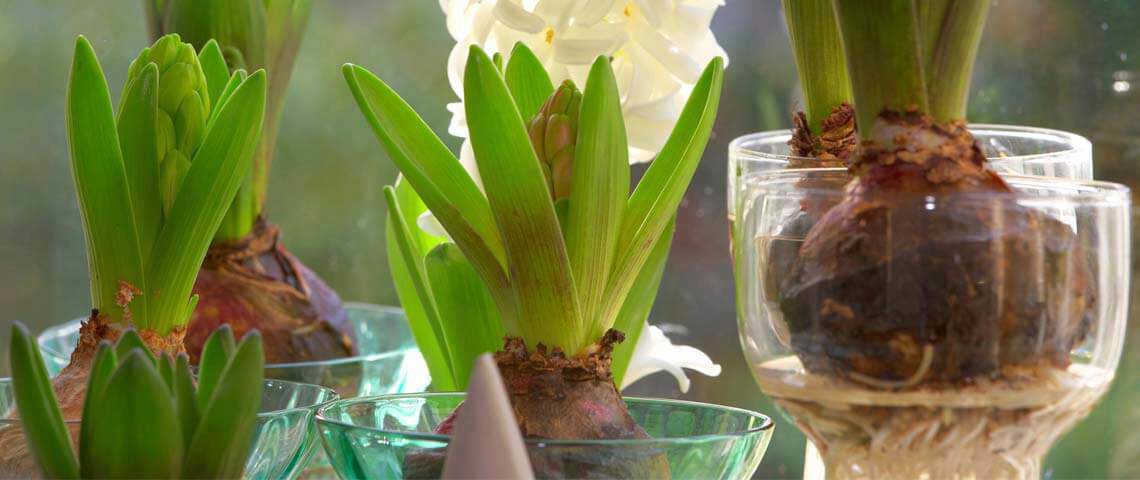Identifying, Fighting and Preventing Lawn Diseases
When disease hits your lawn grasses, control can be difficult unless you know how to identify lawn and grass diseases and correct the causes behind them. Many common lawn and grass diseases have fungal problems at their source. Fortunately, proper lawn maintenance and care prevent and resolve most fungal lawn diseases. To keep your lawn healthy and fungus-free, learn:
How to Identify Common Fungal Lawn Diseases
In order for fungal diseases to strike, you need three factors in play: disease pathogens, weather conditions that favor disease development and susceptible lawn grasses. Without all three factors present, grasses keep the upper hand — but when all three align, it means trouble. While you can't control the weather, you can recognize fungal threats, learn how to identify lawn and grass diseases, and take action.
Active fungal disease usually occurs in times of stress, which vary according to grass growing regions. For example, warm-season grasses are hit when abnormally cool temperatures slow their growth; cool-season grasses are most vulnerable when conditions are warmer than normal. Excessive rain, drought and overcast skies all impact your lawn's ability to fight back.
You can identify the following common fungal lawn and grass diseases for warm- and cool-season grasses with the lawn and grass disease tips that follow:
- Brown patch lawn disease
- Dollar spot lawn disease
- Gray leaf spot lawn disease
- Leaf spot lawn disease
- Pythium lawn disease
- Red thread lawn disease
- Rust lawn disease
- Snow mold lawn disease
- Summer patch lawn disease
Identify Brown Patch Lawn Disease
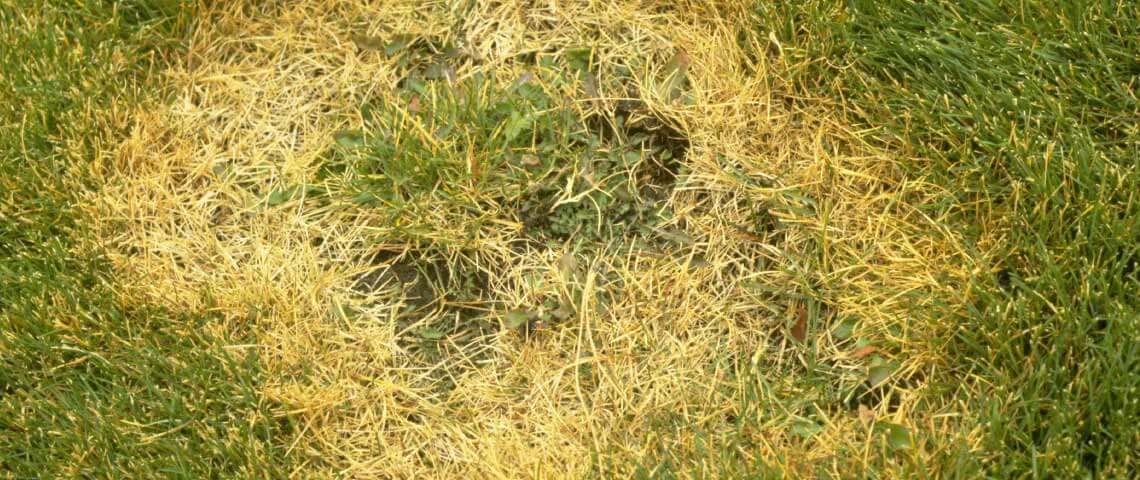
Close-up view of symptoms of Brown Patch in grass.
- Circles of dead, sunken grass appear that can vary in size up to 3 feet wide.
- Grass blades darken, wilt and die, leaving the circle's perimeter smoke-gray in color.
- Perennial ryegrass, tall fescue, bentgrass and Bermudagrass are hit by brown patch most often. Kentucky bluegrass, fine fescue grasses and St. Augustine grass are commonly affected, too.1,2
- In the spring and fall, warm to hot weather conditions set the stage for brown patch lawn disease.
- Wet leaves, high humidity, overfertilizing and excess water facilitate the spread.
Identify Dollar Spot Lawn Disease
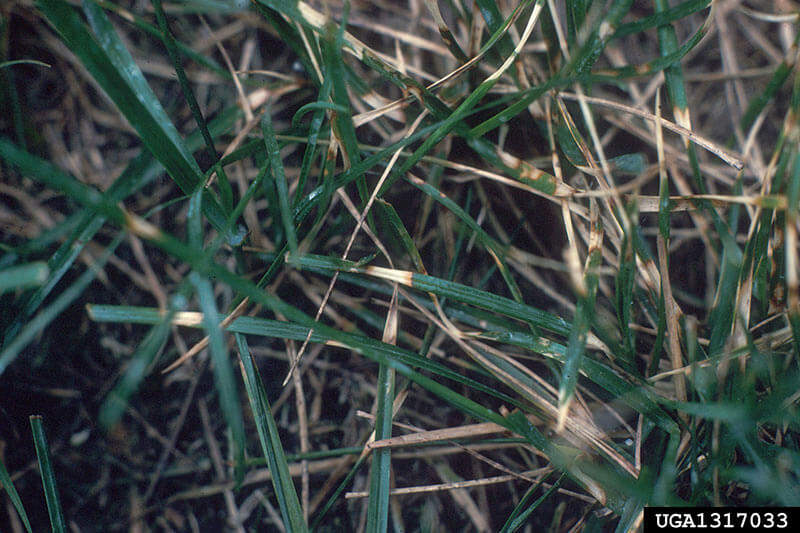
Close-up view of symptoms of Dollar Spot in grass.
- Silver-dollar-size circles spread up to 6 inches wide and eventually merge into large, irregular blocks.
- Grass develops straw-yellow spots that look water-soaked. Morning light reveals cobweb-like growth.
- Dollar spot typically targets fine fescue, perennial ryegrass, bentgrass and centipede grass lawns. Kentucky bluegrass, tall fescue, Bermudagrass and Zoysia grass are often impacted, too.1,2
- Late spring through fall, mild-to-warm temperatures support dollar spot disease development.
- Underfertilizing, excessive moisture, drought stress and thatch leave grasses susceptible.
Identify Gray Leaf Spot Lawn Disease
- Small, irregular patches grow and join together to form large areas of damage.
- Grass blades develop small, bleached-out spots with dark brown edges. The spots turn fuzzy gray when wet.
- Gray leaf spot affects perennial ryegrass and tall fescue grasses most often. It often impacts St. Augustine grass, too.1,2
- Moderately high temperatures with high precipitation from spring to fall favor gray leaf spot's development.
- Poor air circulation, overwatering, overfertilizing and too much shade contribute to the spread of disease.
Identify Leaf Spot Lawn Disease
- Grasses display elongated, oval spots with dark purple-brown margins and brown centers.
- Crowns and roots of grass plants develop dark brown rot, and grasses thin and die out.
- Leaf spot strikes tall fescue, perennial ryegrass and Bermudagrass most often. Kentucky bluegrass, bentgrass and fine fescue grasses are secondary targets.1,2
- Unseasonably warm temperatures threaten cool-season grasses, while unseasonably cool temperatures put warm-season grasses at risk, particularly in overly dry, compacted soil that needs aeration.
- High humidity, extended moisture, mowing too short and too much high-nitrogen fertilizer support the disease.
Identify Pythium Lawn Disease
- Circles of withering, blackened blades expand in patterns that follow the flow of water through the lawn.
- Leaves look greasy and stick together, roots turn brown and rot, and grasses die quickly.
- Perennial ryegrass and bentgrass are most commonly affected by pythium lawn disease. Fine fescue and bluegrasses are also impacted by this disease.1
- Warm temperatures, consistently wet conditions and high humidity from early summer to fall encourage the disease.
- Compacted soil, overfertilizing, overwatering and too much shade hasten the spread.
Identify Red Thread Lawn Disease
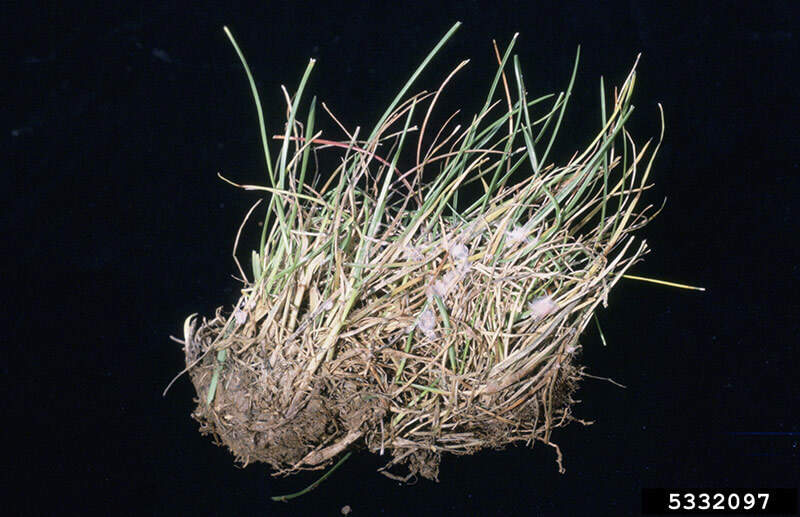
Red Thread (Laetisaria fuciformis) close up.
- Red or bleached-looking patches appear as grass blades wither from the tips.
- Reddish-pink threads bind blades together; red spores show up on shoes, mowers and tools.
- Fine fescue and perennial ryegrass are primary hosts for red thread lawn disease. It often affects bluegrasses and bentgrass as well.1
- Mild, early spring temperatures and cool, wet conditions favor the disease.
- Underfertilizing, high humidity, poor air circulation, too much shade, excess thatch, leaves left wet for extended periods, and compacted soil contribute.
Identify Rust Lawn Disease
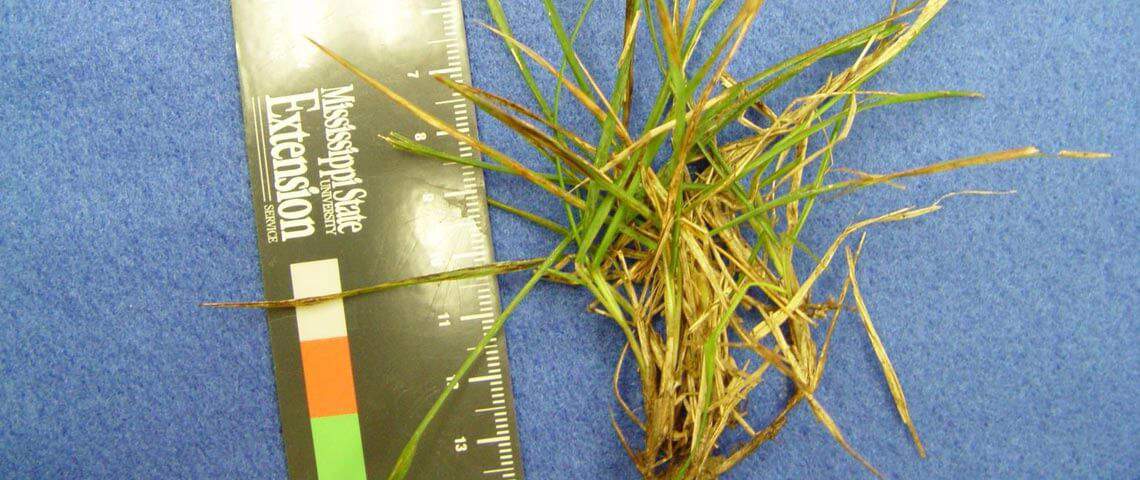
Rust grass disease close up.
- Irregular patches of weak, thinning grass develop yellow specks that become rust-colored.
- Orange-red pustules cover grass blades and hitch a ride on tools, shoes and mowers.
- Rust disease most commonly affects perennial ryegrass, tall fescue, Kentucky bluegrass and Zoysia grass. Fine fescues and bentgrass are also affected.1,2
- Mild to moderately warm temperatures from early summer through fall are primary disease times.
- Drought, high humidity, extended wetness, too much shade and underfertilizing leave stressed grass susceptible.
Identify Snow Mold Lawn Disease
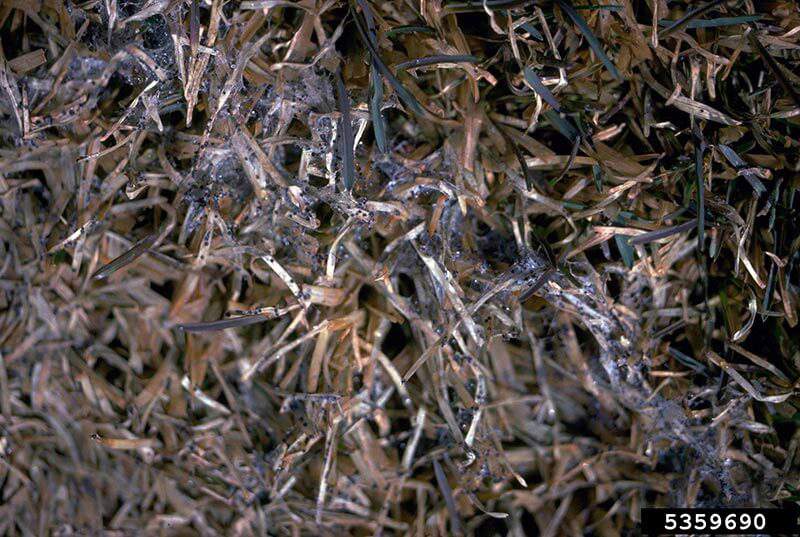
Close up of Snow Mold lawn disease in grass.
- Small, circular, pinkish spots spread up to 1 foot or more.
- Grass blades become water soaked, turn red-brown, and then tan. Morning sun reveals white or pinkish fungal threads.
- Snow mold diseases impact tall and fine fescues most. Bentgrass, perennial ryegrass and Kentucky bluegrass are also affected.1
- Overly cool fall temperatures combined with wet conditions set the stage for disease to strike in winter, especially under snow cover.
- Overfertilizing with too much nitrogen in fall, poor drainage and too much shade leave grass vulnerable.
Identify Summer Patch Lawn Disease
- Circles of dying and dead tan-colored grass show green, healthy-looking grasses in their centers.
- Dark brown fungal threads may cover the crowns, rhizomes and stolons of grass plants.
- Summer patch disease strikes Kentucky bluegrass and fine fescue most often. Perennial ryegrass and bentgrass are secondary targets.1
- Unusually high temperatures in late spring through summer support disease development.
- Excessive soil moisture, compacted soil, poor drainage and mowing too low give the disease an advantage.
How to Treat and Prevent Lawn Diseases
Once you identify a lawn or grass disease, good lawn maintenance can help prevent and correct it. Prevention and prompt adjustments in lawn care at the first signs of trouble restore the advantage to your lawn. Keep your lawn at its competitive peak with these fungal-fighting practices:
- Keep soil pH at a level lawn grasses need
- Fertilize properly
- Water for lawn health, strength and resilience
- Choose premium, water-wise grass seed products
- Follow good mowing practices
- Dethatch lawns and aerate soil regularly
- Use pesticides for severe infestations
1. Keep soil pH at a level lawn grasses need. Most lawn grasses prefer slightly acidic soil near 6.0 to 7.0 pH, where essential nutrients stay readily available. Regular soil testing and appropriate soil amendments help keep your grass healthy and strong.
2. Fertilize properly. Underfertilizing leaves grass undernourished, and overfertilizing promotes weak, rushed growth; both mistakes set up lawns for disease. Fertilize with premium Pennington Full Season lawn fertilizers that feed your lawn for up to four months, with 5% iron for deep greening, to keep your lawn, vibrant and lush. Follow label instructions for proper amounts.
3. Water for lawn health, strength and resilience. Irrigate early in morning when evaporation rates are low and the emerging sun speeds drying, reducing the amount of time grass spends wet. Don't water frequently; instead, water deeply, one to two times weekly, to encourage strong, deep, drought-tolerant roots. Irrigation equal to 1 inch of precipitation soaks soil to a 4- to 6-inch depth, which is perfect for healthy, established grass. Don't leave irrigation on automatic. Adjust to accommodate rainfall or the lack of it.
4. Choose premium, water-wise grass seed products. Use grasses recommended for your region and suited for your yard's sun exposure. The right grass is key to avoiding disease. Pennington Smart Seed grass seed saves up to 30 percent more water versus ordinary grass seed, reducing watering-related problems. Pennington patching and repairing products are ideal for bare lawn spot repairs. Premium Pennington Smart Patch bare spot repair for lawns — available in Sun & Shade, Dense Shade, Tall Fescue, Bermudagrass and Zenith Zoysia mixes — combines drought-tolerant Smart Seed grass seed, professional-grade fertilizer, mulch and a tackifier that keeps seed in place — even when planting on slopes and hills. Plus, Smart Patch seeding mixtures contain beneficial microbials that help neutralize soil and disease problems, improve soil and lawn health, and help prevent disease lawn disease.
5. Follow good mowing practices. Mow at heights recommended for your grass type. Keep your mower blades sharp, and mow according to grass growth, not the calendar. Remove only one-third of the blade height in a single mowing. If you suspect fungal lawn disease, always collect and dispose of lawn clippings—don't compost them. Some diseases spread through clippings can infect your compost pile.
6. Dethatch lawns and aerate soil regularly. Thatch up to 1/2 inch thick acts like beneficial mulch, but amounts beyond that restrict water and air and encourage disease. Compacted soil does the same. Reduce compaction with regular aeration, and dethatch your lawn as needed so air, sun and moisture reach their goal and keep disease at bay.
7. Use pesticides for severe infestations. Most otherwise healthy lawns recover quickly with proper corrections. But when corrections alone aren't sufficient, choose pesticides specifically approved for the disease at hand. Sevin® 3-in-1 Flower & Shrub Ready to Spray helps control several lawn diseases, including brown patch, dollar spot, leaf spot, red thread, rust and summer patch.
Many lawn fungicides are only available to licensed applicators, so preventing lawn problems before they happen is key.
By recognizing conditions that favor lawn diseases and identifying grass diseases, you can solve problems and circumvent the threat of lawn disease promptly. With the help of Pennington grass seed and Pennington lawn health products, you can keep your lawn grasses lush, beautiful and beyond the reach of fungal disease.
Always read product labels thoroughly and follow instructions.
Source:
1. NextGen Turf Research, "Disease Overview: Turfgrass Disease," April 2016.
2. A. Bruneau and L. Lucas, "Diseases of Warm-Season Grasses," North Carolina State Extension, August 1995.

